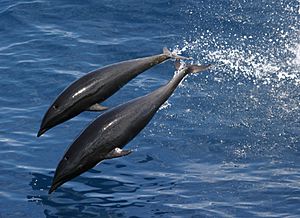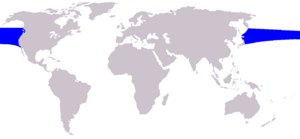Northern right whale dolphin facts for kids
Quick facts for kids Northern right whale dolphin |
|
|---|---|
 |
|
 |
|
| Size compared to an average human | |
| Conservation status | |
| Scientific classification | |
| Genus: |
Lissodelphis
|
| Species: |
borealis
|
 |
|
| Range map | |
The northern right whale dolphin (Lissodelphis borealis) is a small, sleek dolphin. It lives in the cool waters of the North Pacific Ocean. This dolphin is special because it doesn't have a dorsal fin on its back. It looks a bit like a porpoise. It's one of two types of right whale dolphins.
Contents
What They Look Like
The northern right whale dolphin has a smooth, streamlined body. Its forehead slopes gently. It is slimmer than most other delphinids, which are oceanic dolphins. It has no fin or ridge on its back.
Its body is mostly black. It has a white patch on its belly. This patch starts near its tail and widens towards its throat. Baby dolphins are born creamy-dark grey or brown. They get their adult colors by the time they are one year old.
Their beak is short and clear. It has a straight mouthline. Their flippers are small, curved, and pointed. Their tail flukes are triangular and pointed too.
Size and Teeth
Adult northern right whale dolphins are usually 2 to 3 meters (6.5 to 10 feet) long. They weigh between 60 and 100 kilograms (130 to 220 pounds). Females are a bit smaller than males. Males can be around 3 meters long. Both sexes look similar otherwise.
These dolphins have many thin, sharp teeth. They have about 80 to 95 teeth. You cannot see their teeth from the outside. They use these teeth to catch small fish and squid.
Where They Live
Northern right whale dolphins live in the cold to mild waters of the North Pacific Ocean. They prefer water temperatures from 8°C to 24°C (46°F to 75°F). They usually live far from shore in the open ocean. You can find them between 34°N and 55°N latitude. Sometimes, they are seen as far south as Baja California, Mexico. This happens when the water is unusually cold.
Travel and Movement
We don't fully understand how northern right whale dolphins move around. Surveys off the US coast show they might move seasonally. They seem to go north in the summer. Then they move south in the winter. But sometimes, they show different patterns.
You might spot them if you go whale watching off Monterey, California.
Behavior and Habits
Northern right whale dolphins are very fast swimmers. They usually swim around 26 km/h (16 mph). But they can reach speeds of 30 to 40 km/h (19 to 25 mph). When they swim fast, they look like they are bouncing on the water. They make low, graceful leaps together. Sometimes they leap as far as 7 meters (23 feet) in one jump.
They can dive deep to find food. They go down up to 200 meters (660 feet). They hunt for squid and fish, especially lanternfish. They also eat Pacific hake, saury, and other deep-sea fish.
Social Life
Northern right whale dolphins often travel in large groups called pods. These pods can have from 110 to 200 dolphins. Some very large pods have been seen with up to 3,000 dolphins!
They are very social animals. They often swim with Pacific white-sided dolphins. They have also been seen with other marine animals. These include Baird's beaked whales, Dall’s porpoises, humpback whales, pilot whales, Risso’s dolphins, and sperm whales.
Talking Without Whistles
Unlike most dolphins, northern right whale dolphins do not use whistles to communicate. Instead, they make clicks and burst-pulses. These sounds might help them talk to each other. It could be like how other dolphins use their unique whistles. Scientists think they might have stopped whistling to avoid predators. Or it could be because of their large group sizes.
Life Cycle and Reproduction
We don't have much information about how northern right whale dolphins grow and reproduce. Studies suggest that their pregnancy lasts about 12 months. Most calves are born in the summer, around July and August. A female dolphin can have a new calf every two years.
Males grow to about 265 cm (8.7 feet) long. Females grow to about 210 cm (6.9 feet) long.
Population Status
It is thought that about 68,000 northern right whale dolphins live in the Pacific Ocean. Around 26,000 of them live in US waters. Their numbers can change with the seasons and from year to year. This makes it hard to know if their population is growing or shrinking.
Threats to Dolphins
In the past, whalers sometimes caught northern right whale dolphins. In the mid-1900s, a big danger was large-scale squid fishing nets. These nets accidentally caught up to 24,000 dolphins each year in the 1980s. This greatly reduced their numbers in some areas.
Pollution is another concern. While their offshore homes are generally cleaner, some studies have found high levels of harmful chemicals in these dolphins.
We don't know their natural predators for sure. But killer whales and large sharks might hunt them. It's rare for these dolphins to get stranded on beaches.
Noise in the ocean can also bother them. Dolphins use sound to communicate, find food, and navigate. Loud noises from ships or military activities can disturb them.
Protecting Them
The IUCN Redlist says the northern right whale dolphin is of Least Concern. This means they are not currently in danger of extinction.
Their international trade is controlled by CITES. They are listed in CITES Appendix II. This helps manage their numbers.
Many countries have laws to protect them. In Canada, it's illegal to hunt them, except for some aboriginal peoples. In the United States, all dolphins are protected by the Marine Mammal Protection Act of 1972.
One very helpful step was a United Nations ban on large driftnet fishing in the open ocean. This helped reduce accidental catches. Some fisheries now use "pingers" to warn dolphins away from nets. However, it hasn't shown a big difference for northern right whale dolphins yet.
More Information
You can find more about northern right whale dolphins online. Check out the websites of NOAA (National Oceanic and Atmospheric Administration) or WDC (Whale and Dolphin Conservation). You can also find videos online that show how these dolphins behave and the sounds they make.


